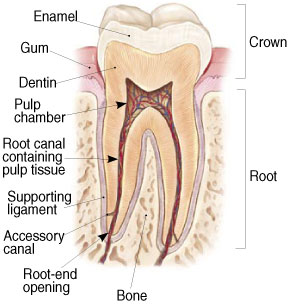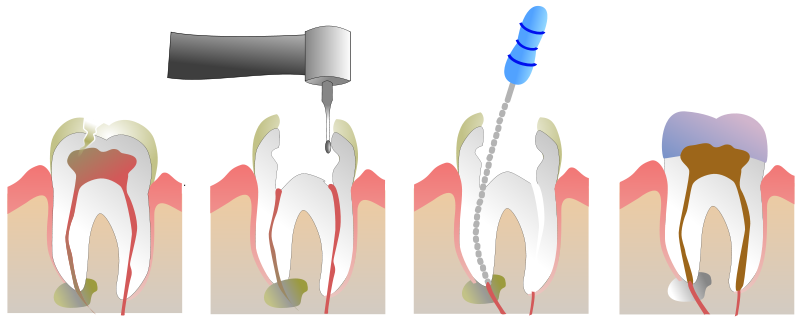Root Canal TreatmentThe aim of Root Canal Treatment (also called ‘endodontic’ treatment) is to save a tooth that has been badly damaged due to decay, disease or injury. Many millions of teeth each year are saved from extraction by having root canal treatment. Most people prefer to save their tooth because it generally will function better than an artificial tooth. Your own tooth is usually stronger and more efficient for biting and chewing. Cleaning and maintenance of a natural tooth are much easier. Root canal treatment is successful in most cases. If you take good care of the treated tooth, it may last for many years and possible for the rest of your life. |
|
Infection or inflammation of the pulpInfection or inflammation of the pulp can be caused by:
Symptoms may include pain, sensitivity to heat and cold, tooth discoloration and swelling or soreness in the gums surrounding the tooth. If the pulp cannot repair itself, it will initially become inflamed. If it is not treated, it will die and become infected. Root Canal Treatment is then needed to save the tooth. To improve the chances of success, root canal treatment should start as soon as possible. All root canals in the affected tooth must be treated. The front teeth (incisors) have one or two root canals. Premolars (bicuspids) typically have one or two root canals. Molars usually have three or four root canals. If the pulp of the tooth is not treated quickly, severe pain and abscesses (infections at the end of the roots) can occur. If the abscess is left untreated, infection can damage the bone surrounding the root. If the tooth does not have endodontic treatment, it will have to be removed. |
|
Steps involved in Root Canal TreatmentThe dentist will examine the tooth and take a radiograph (x-ray film). A local anesthetic is usually given to block pain. A sheet of latex, called rubber dam, is used to isolate the tooth and keep it clean and dry during treatment. To reach the pulp, an opening through the tooth is made with a dental drill. Using special instruments called files, your dentist will remove the inflamed or infected pulp. Each root canal is cleaned, enlarged and shaped. Anti inflammatory and anti bacterial medicines may be put inside the root canal to help stop the inflammation and infection. If a severe abscess has formed at the root tip, oral antibiotics may be needed to treat the infection. You will usually need to make several visits to the dentist to complete the treatment. A temporary filling will protect the inside of the tooth between visits. |
|
Completion of treatment
At the completion of the Root Canal Treatment the temporary filling is removed and tooth is restored with a permanent restoration. If extensive tooth structure has been lost your dentist may recommend a porcelain or gold crown for the root canal treated tooth.
Possible complications of Root Canal Treatment
With a success rate of approximately 95%, Root Canal Treatment is one of the most reliable dental procedures and complications are rare. However, there can be no absolute guarantee regarding treatment success. Some very frequent complications include, but are not limited to: the possibility of perforations of the tooth or root, damage to existing restorations (fillings), the possibility of a split or fractured tooth, the possibility of a separation of a portion of an instrument that cannot be removed from within the tooth, and possibility of pain, swelling and re-infection. Any of these complications could result in failure of the procedure requiring possible re-treatment or extraction of the tooth.
Root Canal Pakenham, Officer, Beaconsfield and Nar Nar Goon



